
[ Archive ]

 |
CIMSS-NOAA Weekly Report [ Archive ] |
 |
ASPB AND CIMSS WEEKLY HIGHLIGHTS FOR THE WEEK ENDING DECEMBER 1, 2018
IN THE PRESS:
Perpetual Notion Machine: On November 29, T. Schmit was the guest on the weekly science program: the Perpetual Notion Machine on WORT radio in Madison, WI. The topic was Geostationary Operational Environmental Satellite (GOES), covering the Applications Technology Satellite in 1966 to GOES-16 and 17. Once posted, the program will be at https://www.wortfm.org/news-talk/news/ioby/perpetual-notion/. (T. Schmit, E/RA2, 608-263-0291)
SSEC and CIMSS Scientists in the News: Scientists at the University of Wisconsin-Madison (UW) Space Science and Engineering Center (SSEC) and the Cooperative Institute for Meteorological Satellite Studies (CIMSS) provide expert commentary, interviews, and imagery to news media and participate in events to promote science. In the news this week: 1) Neil Jacobs, assistant secretary of commerce for environmental observation and prediction at the National Oceanic and Atmospheric Administration (NOAA), held a listening session at the University of Wisconsin-Madison on Nov. 26 to gather public input on the Department of Commerce’s 2018-2022 Strategic Plan and the Weather Research and Forecasting and Innovation Act of 2017. While in Madison, Dr. Jacobs met with Department of Atmospheric and Oceanic Sciences faculty, and NOAA Advanced Satellite Products Branch (ASPB) and SSEC leadership. Read more: https://www.ssec.wisc.edu/news/articles/11464. 2) Volcanic ash can cause major disruptions for global air travel. A new study coauthored by NOAA ASPB scientist Mike Pavolonis, based at CIMSS, describes a method to identify and track ash clouds so that aviation authorities can alter advisories or change flight paths. Read more about the study: https://go.wisc.edu/j1g8xm. 3) CIMSS scientist Jason Otkin was interviewed about a new study that compares agricultural stakeholders’ perceptions of the flash drought that developed across upper Great Plains states in 2016 with datasets used to compile the U.S. Drought Monitor during that same time period. Read more about the study: https://go.wisc.edu/fsxwlw. 4) CIMSS Satellite blog contributor Scott Bachmeier published posts on the "GOES-17/GOES-16 true color composite" (Nov. 26), "Train of standing waves south of Hawai’i" (Nov. 25), and "The first -40º temperature of the winter in Alaska" (Nov. 24). Read more at the CIMSS Satellite Blog: http://cimss.ssec.wisc.edu/goes/blog/. (J. Phillips, SSEC, 608-262-8164, M. Pavolonis, E/RA2, T. Schmit, E/RA2, J. Otkin, CIMSS, S. Bachmeier, CIMSS, R. Kohrs, SSEC)
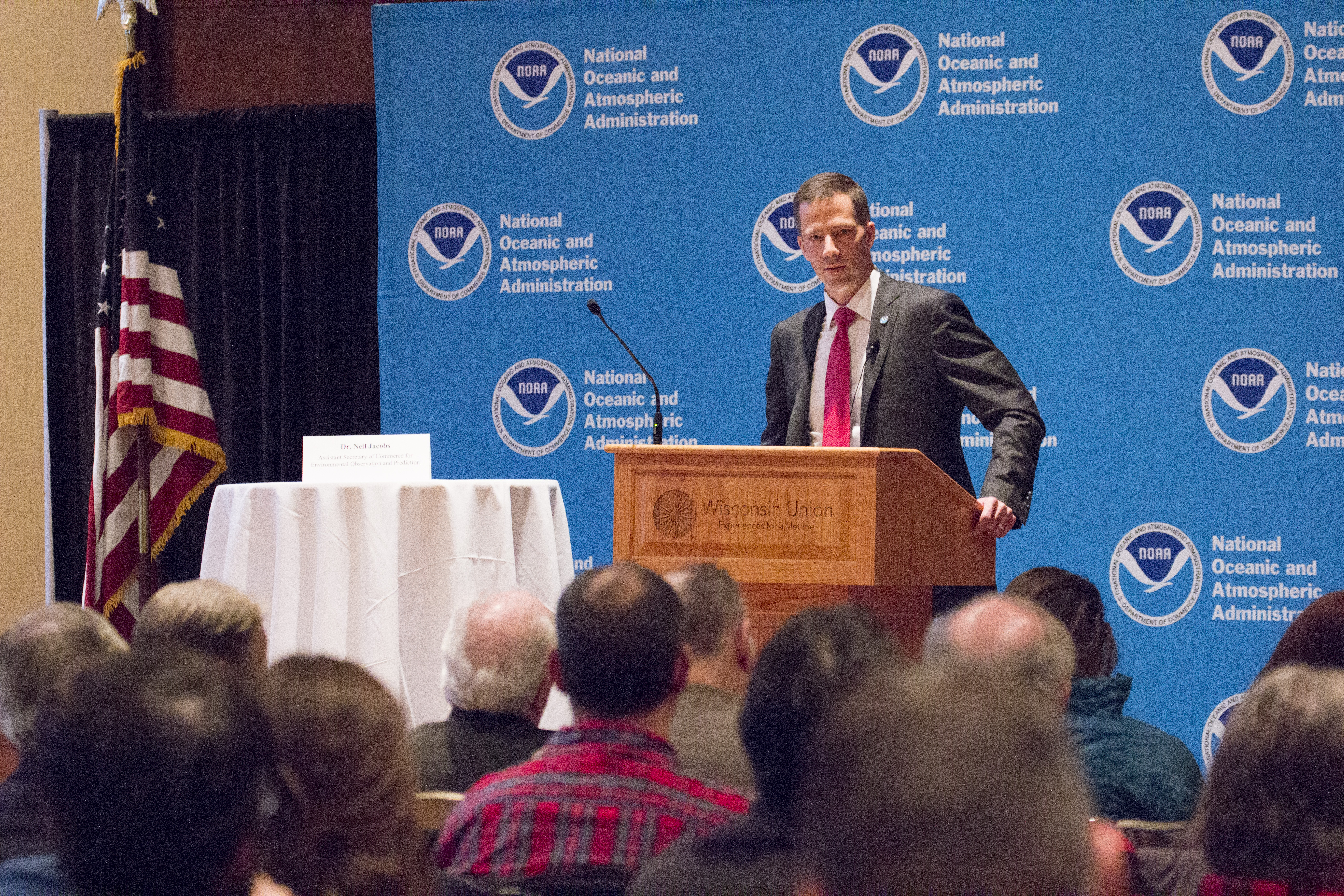 (Click image to enlarge)
(Click image to enlarge)
Figure: Neil Jacobs, NOAA assistant secretary of commerce for environmental observation and prediction, at the Nov. 26 Listening Session in Madison, WI. Credit: Bill Bellon, SSEC.
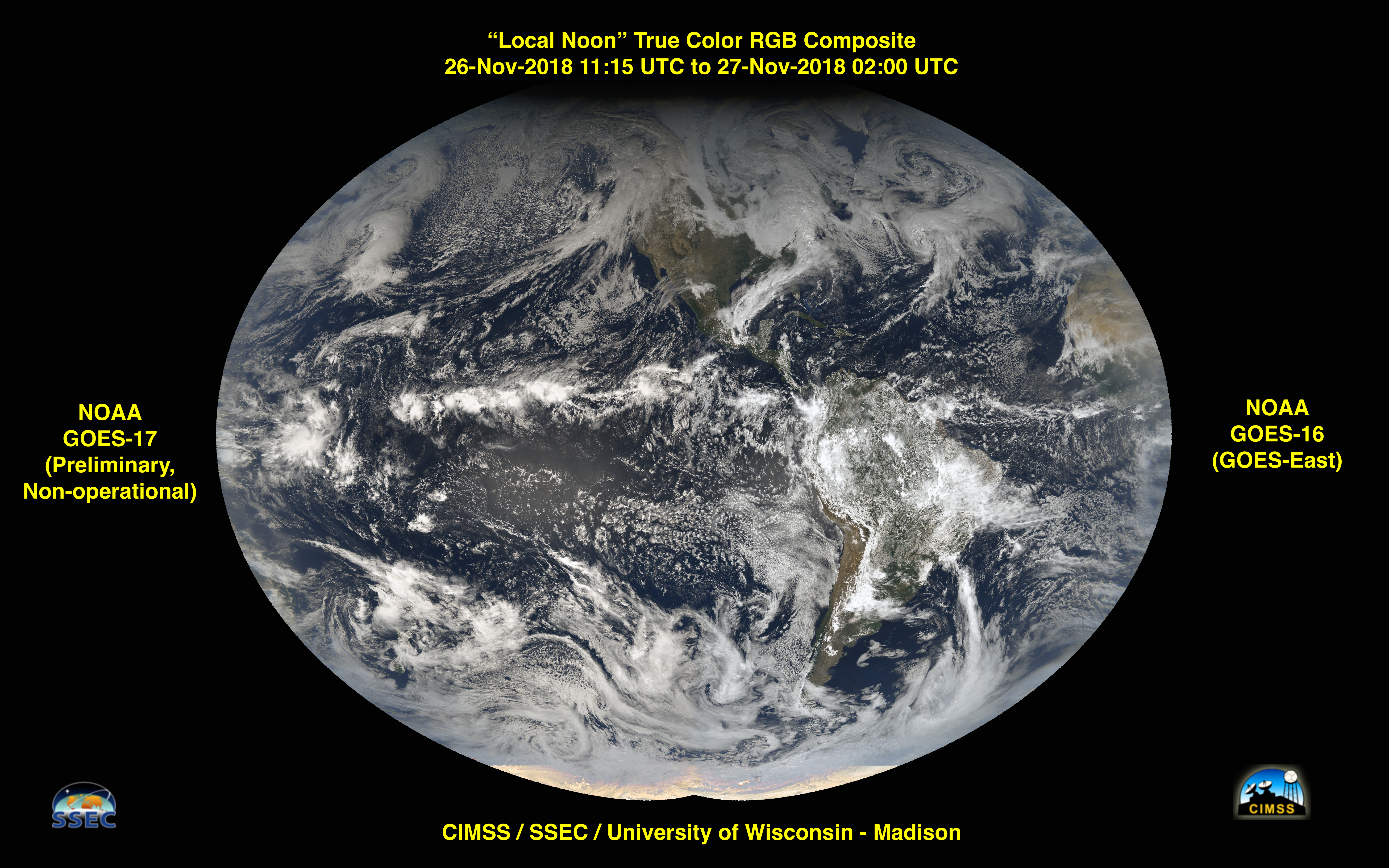 (Click image to enlarge)
(Click image to enlarge)
Figure: A composite of GOES-17 and GOES-16 true color, red-green-blue (RGB) imagery. More on the technique at http://cimss.ssec.wisc.edu/goes/blog/archives/30878. Credit: Rick Kohrs, SSEC.
ITEMS FOR THE ADMINISTRATOR:
ITEMS FOR THE ASSISTANT ADMINISTRATOR:
ITEMS FOR THE OFFICE DIRECTOR, STAR:
Paper Published on Single-Band Ice Surface Temperature Retrieval: A paper titled "Ice Surface Temperature Retrieval from a Single Satellite Imager Band", by Yinghui Liu (Cooperative Institute for Meteorological Satellite Studies), Richard Dworak (CIMSS), and Jeff Key (STAR), was published in the journal Remote Sensing (doi:10.3390/rs10121909). Current methods for estimating the surface temperature of sea and lake ice - the ice surface temperature (IST) - utilize two satellite imager thermal bands (11 and 12 μm) at moderate spatial resolution. A single-band algorithm would be useful for satellite imagers that have only the 11 μm band at high resolution, such as the Visible Infrared Imaging Radiometer Suite (VIIRS), or that do not have a fully functional 12 μm band, such as the Thermal Infrared Sensor onboard the Landsat 8. This study presents a method for single-band IST retrievals, and validation of the retrievals using IST measurements from an airborne infrared radiation pyrometer during the NASA IceBridge campaign in the Arctic. Results show that IST with a single thermal band from the VIIRS has comparable performance to IST with the VIIRS dual-band (split-window) method, with a bias of 0.22 K and root-mean-square error of 1.03 K. The manuscript is available online at http://bit.ly/2TS87zQ. (J. Key, E/RA2, 608-263-2605, jeff.key@noaa.gov; Y. Liu, CIMSS, 608-265-8620; R. Dworak, CIMSS)
GOES-17 Radiance and Imagery Passes Provisional Stage Review: A Geostationary Operational Environmental Satellite (GOES)-17 Advanced Baseline Imager (ABI) Provisional Peer Stakeholder - Product Validation Review (PS-PVR) was held on November 28, 2018 for radiances and Cloud and Moisture Imagery. T. Schmit and M. Gunshor both presented covering the imagery portion. Both the radiances and imagery passed to the provisional stage, which means that the imagery product is ready for operational use but has documented known issues; the review focused on the times of year less impacted by the GOES-17 Loop Heat Pipe issue. (M. Gunshor, CIMSS; T. Schmit, E/RA2, 608-263-0291)
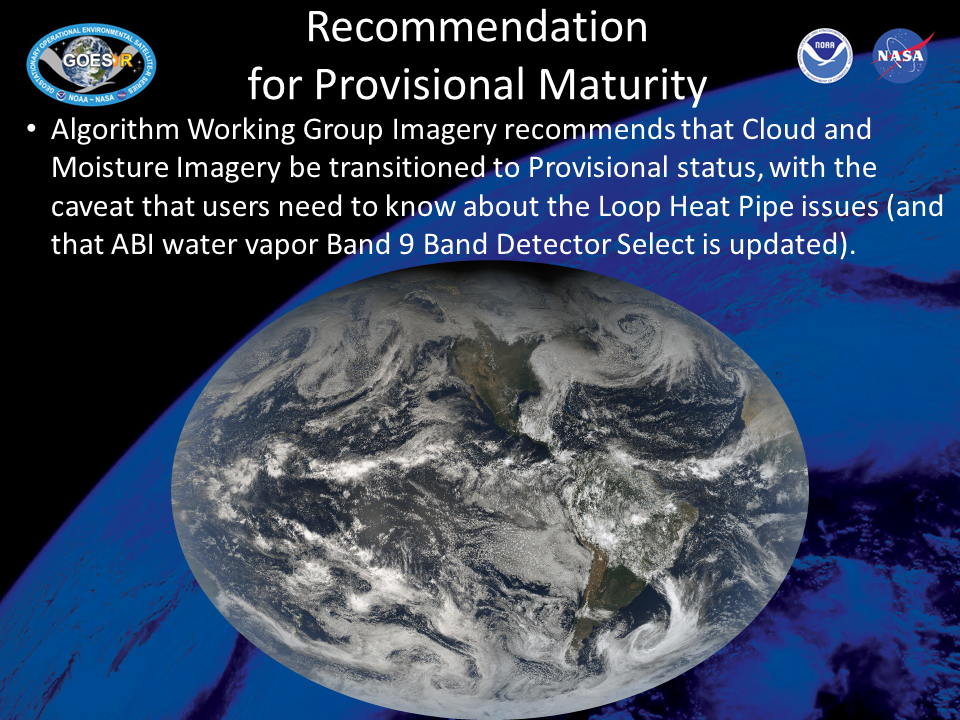 (Click image to enlarge)
(Click image to enlarge)
Figure: A slide from the GOES-17 Cloud and Moisture Imagery provisional stage review. The image is an Advanced Baseline Imager (ABI) natural color combined from GOES-16 (east) and GOES-17 (west) in a Mollweide projection from November 26-27, 2018.
GEWEX DAP Meeting: This week, the Data and Analysis Panel (DAP) of the Global Energy and Water Exchanges (GEWEX) project met in Lisbon, Portugal at the Headquarters of the Portuguese Institute for Sea and Atmosphere (IPMA). The GEWEX-DAP guides and evaluates the generation of long-term global data sets from satellites and other sources. Therefore GEWEX-DAP's mission is highly relevant to NESDIS. Andy Heidinger is member of GEWEX-DAP and contributes as an expert in the cloud remote sensing community. GEWEX-DAP is now considering the creation of a new International Satellite Cloud Cloud Climatology Project (ISCCP) based on the next generation polar and geo meteorological satellites being launched now (including those from NOAA). A. Heidinger will help formulate this project and will run a workshop later this year. (A. Heidinger, E/RA2, andrew.heidinger@noaa.gov)
Global Cryosphere Watch Steering Group Meeting: The World Meteorological Organization (WMO) Global Cryosphere Watch (GCW) Steering Group held its sixth meeting in Davos, Switzerland, 26-29 November 2018. The meetings were hosted by the WSL Institute for Snow and Avalanche Research (SLF). Jeff Key participated as a member of the Steering Group. He discussed GCW products, information, services, and regional activities, including JPSS snow and ice products. The focus of this meeting was the development of the GCW Plan for the Preoperational Phase. GCW will become a WMO operational program in 2024. (J. Key, E/RA2, 608-263-2605, jeff.key@noaa.gov)
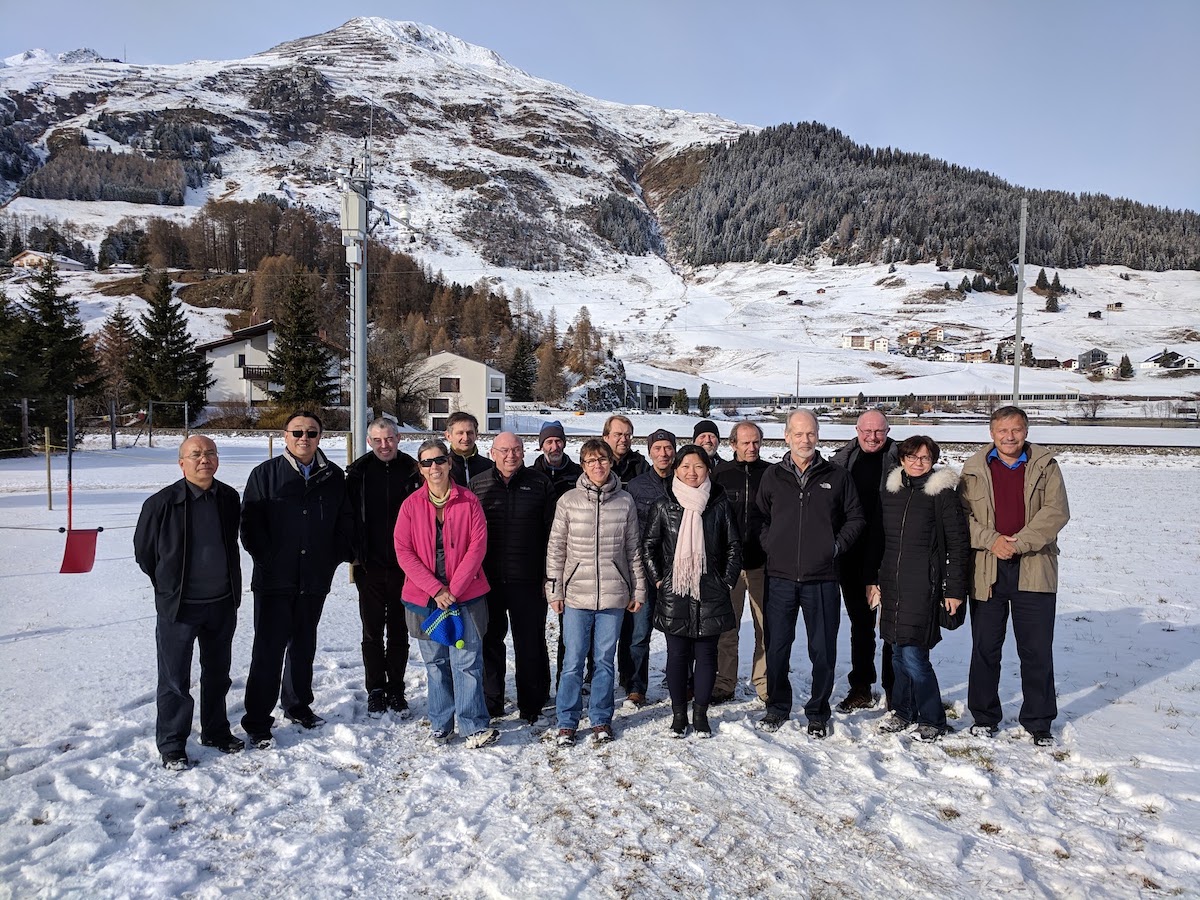 (Click image to enlarge)
(Click image to enlarge)
Figure: The GCW Steering Group in Davos, Switzerland.
ITEMS FOR THE DIVISION CHIEF, CoRP:
CIMSS Forecast Support for University of Wisconsin Home Football Games: This year, the University of Wisconsin (UW) football team had seven home games at Camp Randall Stadium between late August and late November. Cooperative Institute for Meteorological Satellite Studies (CIMSS) employees provided weather guidance to the UW Police, focused on hazards including lightning, strong winds, extreme heat, and sharp temperature changes. Weather observed at the games ranged from sultry (87 degrees on 15 September) to snow squalls with limited visibility (20 October). Information before the games from CIMSS scientists/forecasters helped the Athletic Department and UW Police in planning for impacts; Nowcasts during the game alerted them of imminent changes in weather. (Shane Hubbard, CIMSS, 608 263 3712; J. Gerth, CIMSS, 608 263 4942; J. Sieglaff, 608 265 5357; W. Feltz, CIMSS, 608 265 6283; T. Wagner, CIMSS, 608 265 8620; J. Cintineo, CIMSS, 608 890 0691; S. Lindstrom, 608 263 4425)
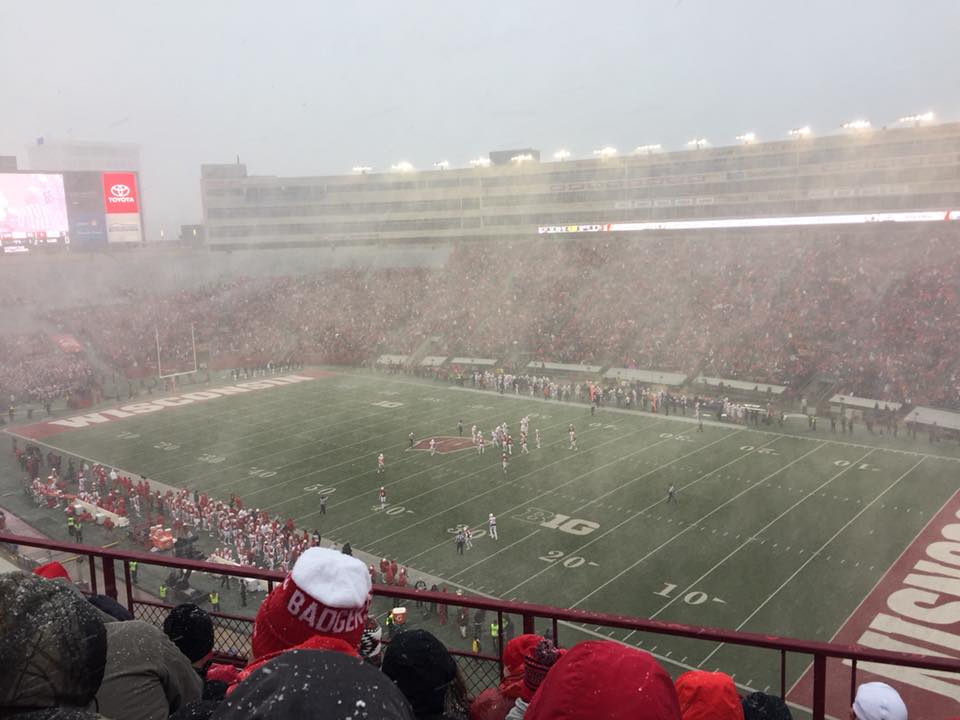 (Click image to enlarge)
(Click image to enlarge)
Figure: Snow Squalls in Camp Randall during the 20 October 2018 Wisconsin-Illinois Football game (Photo courtesy Jessica Braun, UW-Madison SSEC/CIMSS)
VISITORS:
NEXT WEEK:
LOOKING AHEAD:
| Archived Weeklies Page | Submit a report item |